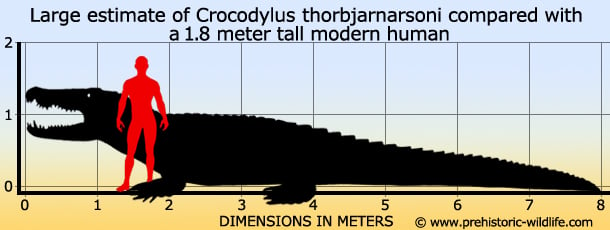Post by dinosauria101 on Feb 18, 2019 18:53:28 GMT 5
Allosaurus fragilis
Allosaurus is a genus of carnivorous theropod dinosaur that lived 155 to 150 million years ago during the late Jurassic period (Kimmeridgian to early Tithonian). Allosaurus was a typical large theropod, having a massive skull on a short neck, a long tail and reduced forelimbs. Allosaurus fragilis, the best-known species, had an average length of 8.5 m (28 ft), with the largest definitive Allosaurus specimen (AMNH 680) estimated at 9.7 meters (32 feet) long, and an estimated weight of 2.3 metric tons (2.5 short tons). As with dinosaurs in general, weight estimates are debatable, and since 1980 have ranged between 1,500 kilograms (3,300 pounds), 1,000 to 4,000 kg (2,200 to 8,800 lb), and 1,010 kilograms (2,230 pounds) for modal adult weight (not maximum). Using the subadult specimen nicknamed "Big Al", researchers using computer modelling arrived at a best estimate of 1,500 kilograms (3,300 lb) for the individual, but by varying parameters they found a range from approximately 1,400 kilograms (3,100 lb) to approximately 2,000 kilograms (4,400 lb).

Crocodylus thorbjarnarsoni
Crocodylus thorbjarnarsoni is an extinct species of crocodile from the Pliocene and Pleistocene of the Turkana Basin in Kenya. It is closely related to the species Crocodylus anthropophagus, which lived during the same time in Tanzania. C. thorbjarnarsoni could be the largest known true crocodile, with the largest skull found indicating a possible total length up to 7.6 m (25 ft). It may have been a predator of early hominins. The largest C. thorbjarnarsoni skull found (KNM-ER 1682) measures 85 cm (33 in) from the tip of the snout to the back of the skull table, in comparison, the largest known extant Crocodylus skull is that of a saltwater crocodile, measuring 76 cm (30 in). Based on regression analysis for Crocodylus, this corresponds to a total length of 6.2–6.5 m (20–21 ft) but such analysis have been shown to underestimate the size of very large individuals by as much as 20%, which means it could have been as long as 7.6 m (25 ft).

Credit to Wikipedia
Allosaurus is a genus of carnivorous theropod dinosaur that lived 155 to 150 million years ago during the late Jurassic period (Kimmeridgian to early Tithonian). Allosaurus was a typical large theropod, having a massive skull on a short neck, a long tail and reduced forelimbs. Allosaurus fragilis, the best-known species, had an average length of 8.5 m (28 ft), with the largest definitive Allosaurus specimen (AMNH 680) estimated at 9.7 meters (32 feet) long, and an estimated weight of 2.3 metric tons (2.5 short tons). As with dinosaurs in general, weight estimates are debatable, and since 1980 have ranged between 1,500 kilograms (3,300 pounds), 1,000 to 4,000 kg (2,200 to 8,800 lb), and 1,010 kilograms (2,230 pounds) for modal adult weight (not maximum). Using the subadult specimen nicknamed "Big Al", researchers using computer modelling arrived at a best estimate of 1,500 kilograms (3,300 lb) for the individual, but by varying parameters they found a range from approximately 1,400 kilograms (3,100 lb) to approximately 2,000 kilograms (4,400 lb).

Crocodylus thorbjarnarsoni
Crocodylus thorbjarnarsoni is an extinct species of crocodile from the Pliocene and Pleistocene of the Turkana Basin in Kenya. It is closely related to the species Crocodylus anthropophagus, which lived during the same time in Tanzania. C. thorbjarnarsoni could be the largest known true crocodile, with the largest skull found indicating a possible total length up to 7.6 m (25 ft). It may have been a predator of early hominins. The largest C. thorbjarnarsoni skull found (KNM-ER 1682) measures 85 cm (33 in) from the tip of the snout to the back of the skull table, in comparison, the largest known extant Crocodylus skull is that of a saltwater crocodile, measuring 76 cm (30 in). Based on regression analysis for Crocodylus, this corresponds to a total length of 6.2–6.5 m (20–21 ft) but such analysis have been shown to underestimate the size of very large individuals by as much as 20%, which means it could have been as long as 7.6 m (25 ft).

Credit to Wikipedia




